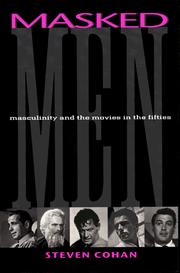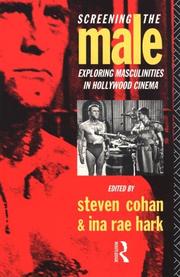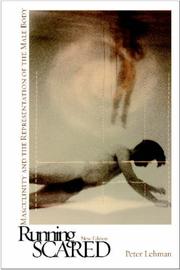| Listing 1 - 10 of 27 | << page >> |
Sort by
|
Book
ISBN: 9780230232006 Year: 2013 Publisher: Basingstoke Palgrave Macmillan
Abstract | Keywords | Export | Availability | Bookmark
 Loading...
Loading...Choose an application
- Reference Manager
- EndNote
- RefWorks (Direct export to RefWorks)
Masculinity in motion pictures --- Men in motion pictures --- Motion pictures
Book
ISBN: 1282921118 9786612921117 0822385589 Year: 2004 Publisher: Durham : Duke University Press,
Abstract | Keywords | Export | Availability | Bookmark
 Loading...
Loading...Choose an application
- Reference Manager
- EndNote
- RefWorks (Direct export to RefWorks)
Argues that although the last two decades of Korean history were a period of progress in political democratization, the country refused to part from a "masculine point of view" which is also mirrored in Korean cinema.
Motion pictures --- Men in motion pictures. --- Masculinity in motion pictures.

ISBN: 0585026238 9780585026237 0253332974 0253211271 9780253332974 9780253211279 Year: 1997 Publisher: Bloomington Indiana University Press
Abstract | Keywords | Export | Availability | Bookmark
 Loading...
Loading...Choose an application
- Reference Manager
- EndNote
- RefWorks (Direct export to RefWorks)
Men in motion pictures. --- Masculinity --- Masculinity (Psychology) --- Sex (Psychology) --- Men --- Motion pictures --- History
Book
ISBN: 9781101946992 1101946997 Year: 2019 Publisher: New York Alfred A. Knopf
Abstract | Keywords | Export | Availability | Bookmark
 Loading...
Loading...Choose an application
- Reference Manager
- EndNote
- RefWorks (Direct export to RefWorks)
Introduction: Naked at the window -- The iceman cometh -- A powder-puff? -- Is this allowed? -- Hideaway -- Codes and codebreakers -- The Goddamn monster -- Gable and Cukor -- Tracy and Hepburn -- Buddies and cowboys -- "The cat's in the bag, the bag's in the river" -- Dead attractive: Cary Grant -- Indecency, gross, or mass market? -- The male gaze -- Perverse -- Burning man -- Gigolo -- Doing it, saying it -- An open door -- Acknowledgments -- Index. From the celebrated film critic and author of The Biographical Dictionary of Film, an original, seductive account of sexuality in the movies and of how actors and actresses on screen have fed our desire. Film can make us want things we can not have. But, while sometimes rapturous, the interaction of onscreen beauty and private desire speaks to a crisis in American culture, one that pits delusions of male supremacy against feminist awakening and the spirit of gay resistance. Combining criticism, his encyclopedic knowledge of film history, and memoir, David Thomson examines how film has found the fault lines in traditional masculinity and helped to point the way past it toward a more nuanced understanding of what it means to be a person desiring others. Ranging from advertising to pornography, Rudolph Valentino to Moonlight , Rock Hudson to Call Me By Your Name , Katharine Hepburn and Cary Grant to Phantom Thread , Thomson shows us the art and the artists we love under a new light. He illuminates the way in which film as art, entertainment, and business has been a polite cover for a kind of erotic séance. And he makes us see how the way we watch our movies is a kind of training for how we try to live.
Book
ISBN: 0522872484 9780522872484 Year: 2019 Publisher: Carlton, Victoria, Australia
Abstract | Keywords | Export | Availability | Bookmark
 Loading...
Loading...Choose an application
- Reference Manager
- EndNote
- RefWorks (Direct export to RefWorks)
Set against the shifting social and political backdrop of a nation throwing off the shackles of one war yet faced with the instability of the new world order, Reel Men probes the concept of 1950s masculinity itself, asking what it meant to be an Australian man at this time. Offering a compelling exploration of the Australian fifties, the book challenges the common belief that the fifties was a 'dead' era for Australian filmmaking. Reel Men engages with fourteen Australian feature films made and released between 1949 and 1962, and examines the multiple masculinities in circulation at this time. Dealing with beloved Australian films like Jedda (1955), Smiley (1956), and The Shiralee (1957), and national icons of the silver screen including Chips Rafferty, Charles 'Bud' Tingwell, and Peter Finch, Reel Men delves into our cultural past to dismantle powerful assumptions about film, the fifties, and masculinity in Australia.
Masculinity in motion pictures. --- Men in motion pictures. --- Motion pictures --- History

ISBN: 1283606054 9786613918505 1134900104 0203142217 9781134900107 9780203142219 0415077583 9780415077583 0415077591 9780415077590 9781134900053 1134900058 9781134900091 1134900090 9781138169517 113816951X 9781283606059 6613918504 Year: 1993 Publisher: London New York Routledge
Abstract | Keywords | Export | Availability | Bookmark
 Loading...
Loading...Choose an application
- Reference Manager
- EndNote
- RefWorks (Direct export to RefWorks)
Screening the male re-examines the problematic status of masculinity both in Hollywood cinema and feminist film theory.Classical Hollywood cinema has been theoretically established as a vast pleasure machine, manufacturing an idealized viewer through its phallocentric ideological apparatus. Feminist criticism has shown how difficult it is for the female viewer to resist becoming implicated in this representational system. But the theroies have overlooked the significance of the problem itself - of the masuline motivation at the core of the system. The essays here explore those mal
Men in motion pictures. --- Sex in motion pictures. --- Sex in moving-pictures --- Motion pictures --- Erotic films --- Pornographic films

ISBN: 081433556X 9780814335567 9780814333396 0814333397 Year: 2007 Publisher: Detroit Wayne State University Press
Abstract | Keywords | Export | Availability | Bookmark
 Loading...
Loading...Choose an application
- Reference Manager
- EndNote
- RefWorks (Direct export to RefWorks)

ISBN: 1281294993 9786611294991 1847141498 9781847141491 9780826486523 0826486525 0826486525 9781281294999 6611294996 1847062628 Year: 2006 Publisher: London New York Continuum
Abstract | Keywords | Export | Availability | Bookmark
 Loading...
Loading...Choose an application
- Reference Manager
- EndNote
- RefWorks (Direct export to RefWorks)
Looks at a range of fiction and film texts, since 1950's, in order to analyse the ways in which masculinity has been represented in popular culture in Britain and the United States. This work covers numerous genres, including spy fiction, science fiction, the Western and police thrillers.
Book
ISBN: 1283206781 9786613206787 1441166882 9781441166883 9781283206785 9780826499554 0826499554 6613206784 Year: 2008 Publisher: London New York, NY Continuum
Abstract | Keywords | Export | Availability | Bookmark
 Loading...
Loading...Choose an application
- Reference Manager
- EndNote
- RefWorks (Direct export to RefWorks)
Male Jealousy: Literature and Film is a critical and cultural theory-based study of male jealousy in western culture and its connections with paranoia. By tracing the meanings of jealousy and the representation of jealous men (married or unmarried, heterosexual or homosexual), Lo argues that jealousy is promoted within patriarchy and within what Derrida characterises as logocentricism, where to love is the desire to be loved, and where love cannot be guaranteed in any form of sexual relationship. Contrasting the difference between jealousy and its closely linked concept, envy, this book explor
Jealousy in literature. --- Men in literature. --- European literature --- Jealousy in motion pictures. --- Men in motion pictures. --- Motion pictures --- History and criticism.
Book
ISBN: 1442275650 1442233591 9781442233591 9781442233584 1442233583 9781442275652 Year: 2014 Publisher: Lanham
Abstract | Keywords | Export | Availability | Bookmark
 Loading...
Loading...Choose an application
- Reference Manager
- EndNote
- RefWorks (Direct export to RefWorks)
This volume examines films produced by Pixar Animation Studios between 1995 and 2013, exploring how boys become men and how men measure up in films from Toy Story to Monsters University. Offering counterintuitive readings of such works, this book describes how the films quietly but forcefully reiterate traditional masculine norms, in terms of what they praise and what they condemn.
Masculinity in motion pictures. --- Men in motion pictures. --- Animated films --- Motion pictures --- History and criticism. --- Pixar (Firm) --- Pixar Animation Studios --- Disney Pixar (Firm)
| Listing 1 - 10 of 27 | << page >> |
Sort by
|

 Search
Search Feedback
Feedback About UniCat
About UniCat  Help
Help News
News